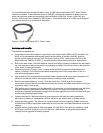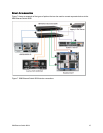IBM Ethernet Switch B24X 8
Security
z
802.1x authentication, accounting, port security, and dynamic assignment for ACLs, MAC
z
filtering, and VLANs
Up to 1,534 inbound, rule-based (hardware-based) access control list (ACL) entries
z
Standard ACLs based on source IP address
z
Extended ACLs based on source and destination IP addresses or IP protocol information
z
Authorization, Authentication, and Accounting (AAA) support on RADIUS, TACACS, and
z
TACACS+
Multi-device authentication, which validates and applies security policies based on MAC
z
address information from a RADIUS server
AES encryption for SSHv2
z
Denial of Service protection against Smurf (ICMP) and TCP SYN attacks in hardware
z
Management
z
Industry-standard CLI via Telnet and SSHv2
z
Fault management integration with IBM Systems Director v6.2
z
Network-wide management of all IBM b-type system networking switches using Brocade
z
Ironview Network Manager (INM)
Simple Network Management Protocol (SNMP) v1/v2/v3
z
sFlow v5 for hardware-based packet sampling
z
Ties into industry tools such as Brocade INM and InMon products for trend analysis
z
and automated policy application
Remote Monitoring (RMON) protocol
z
Link Layer Discovery Protocol (LLDP), Cisco Discovery Protocol (CDP), and Foundry
z
Discovery Protocol (FDP)
Simple Network Time Protocol (SNTP)
z
Firmware image update via TFTP and SCP
z
Monitoring
z
Syslog support of up to six Syslog servers for centralized log collection and analysis.
z
Port mirroring of inbound and outbound traffic.
z
Digital optical monitoring monitors power levels and temperatures of optical transceivers and
z
sends an alert if operating out of specification.
Temperature monitoring sends alerts if the temperature exceeds a certain threshold and
z
shuts down the device after an extended period of time.
Port flap dampening increases network resiliency by limiting the number of port state
z
transitions on an interface.
Link Fault Signaling (LFS) detects and reports fault conditions on 10 GbE ports.
z
Uni-Directional Link Detection (UDLD) monitors the link between two devices and brings the
z
port down if the link goes down on either end.


















